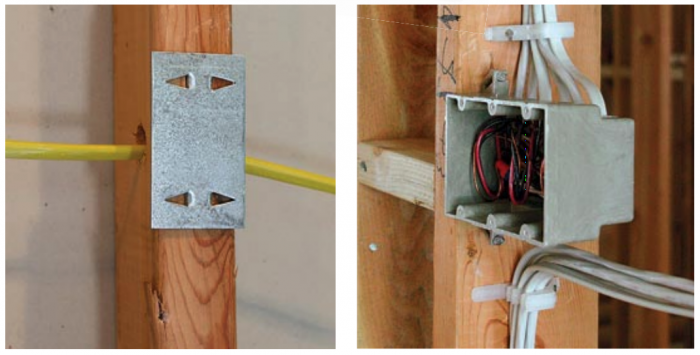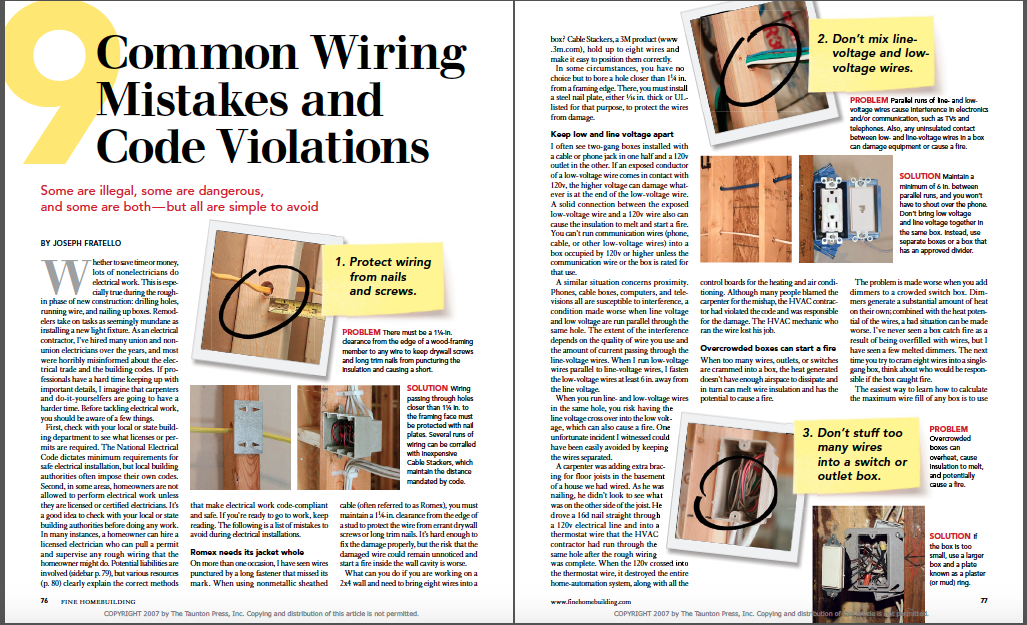9 Common Wiring Mistakes and Code Violations
Some are illegal, some are dangerous, and some are both—but all are simple to avoid.

Synopsis: Many brave homeowners take on electrical work in the course of everyday household maintenance, but it is all too easy to make a code-violating error that could bring on both minor and major problems. Electrical contractor Joseph Fratello outlines nine of the most common wiring mistakes and code violations, and the way to approach the work properly and do it right. Among the common errors: damaging the jacket of non-metallic sheathed cable; mixing line- and low-voltage wires; not using a splice box when installing a new light fixture; overcrowding holes with too many wires; and putting HVAC ducts too close to carbon-monoxide and smoke detectors. Joseph stresses the importance of learning about both the National Electrical Code and also the local variations to the electrical code.
Whether to save time or money, lots of non-electricians do electrical work. This is especially true during the rough-in phase of new construction: drilling holes, running wire, and nailing up boxes. Remodelers take on tasks as seemingly mundane as installing a new light fixture. As an electrical contractor, I’ve hired many union and nonunion electricians over the years, and most were horribly misinformed about the electrical trade and the building codes. If professionals have a hard time keeping up with important details, I imagine that carpenters and do-it-yourselfers are going to have a harder time. Before tackling electrical work, you should be aware of a few things.
First, check with your local or state building department to see what licenses or permits are required. The National Electrical Code dictates minimum requirements for safe electrical installation, but local building authorities often impose their own codes. Second, in some areas, homeowners are not allowed to perform electrical work unless they are licensed or certified electricians. It’s a good idea to check with your local or state building authorities before doing any work. In many instances, a homeowner can hire a licensed electrician who can pull a permit and supervise any rough wiring that the homeowner might do. Potential liabilities are involved, but various resources clearly explain the correct methods that make electrical work code-compliant and safe. If you’re ready to go to work, keep reading. The following is a list of mistakes to avoid during electrical installations.
Romex needs its jacket whole
On more than one occasion, I have seen wires punctured by a long fastener that missed its mark. When using nonmetallic sheathed cable (often referred to as Romex), you must maintain a 1 1/4-in. clearance from the edge of a stud to protect the wire from errant drywall screws or long trim nails. It’s hard enough to fix the damage properly, but the risk that the damaged wire could remain unnoticed and start a fire inside the wall cavity is worse.
What can you do if you are working on a 2×4 wall and need to bring eight wires into a box? Cable Stackers, a 3M product, hold up to eight wires and make it easy to position them correctly.
In some circumstances, you have no choice but to bore a hole closer than 1 1/4 in. from a framing edge. There, you must install a steel nail plate, either 1/16 in. thick or UL-listed for that purpose, to protect the wires from damage.
Keep low and line voltage apart
I often see two-gang boxes installed with a cable or phone jack in one half and a 120v outlet in the other. If an exposed conductor of a low-voltage wire comes in contact with 120v, the higher voltage can damage whatever is at the end of the low-voltage wire. A solid connection between the exposed low-voltage wire and a 120v wire also can cause the insulation to melt and start a fire. You can’t run communication wires (phone, cable, or other low-voltage wires) into a box occupied by 120v or higher unless the communication wire or the box is rated for that use…

To see all 9 common wiring mistakes, click the View PDF button below to read the entire article.
From Fine Homebuilding #190
More about residential wiring:
Electrical Outlets by the Numbers – Building codes dictate specific height and spacing measurements for receptacles and switches. Learn what the most common dimensions are and why.
Upside-down Electrical Outlet? – Here’s some insight on the highly debated topic of which way it’s best to orient wall receptacles when wiring a house circuit.
Is Your Old Wiring Safe? – Inspect the electrical panel and exposed wiring throughout your house to identify safety risks, fire hazards, and upgrade options.





